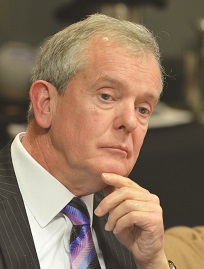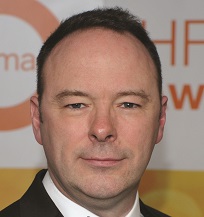Feature / Eyes on the prize
 Carter review trusts tell Seamus Ward about their experiences and how it has helped their drive for greater productivity and efficiency
Carter review trusts tell Seamus Ward about their experiences and how it has helped their drive for greater productivity and efficiency
The final Carter report on efficiency and productivity left acute trusts with many questions, and there is a feeling in the NHS that its publication may have been rushed to show that action was being taken in the face of projected deficits. However, there is also a belief that Carter has left plenty for trusts to get their teeth into.
Certainly, that’s the message coming from some of the trusts with some experience of the Carter process. The review initially included 22 acutes, later increased to 32, which engaged with the Carter team to
discuss performance data and identify and codify what good looks like.
This led to a set of benchmarks and indicators, including the creation of new metrics such as care hours per patient day, to form the basis of a model hospital.
But what of the process itself and do these trusts have any pointers or best practice to hand on to acutes that are now getting to grips with Carter?
Door to savings
Simon Worthington, Bolton NHS Foundation Trust’s deputy chief executive and director of finance, says the Carter work is challenging, but has opened the door to savings (see box, page 26).
‘Trusts now have individual reports setting out how much they can save. It might say they can save £70m – they might challenge that, but the potential savings are not going to be nothing. There are definite opportunities.’
Often, the Carter work turned up little that was new for the Bolton trust. This is hardly surprising, as it had already identified a variety of savings opportunities through extensive benchmarking as part of its financial turnaround.
‘It confirmed things we had already identified,’ says Mr Worthington, ‘but if trusts have not done the work that we did, there will be things identified that they will not have known about.’
With a reference cost index of 92 and with much of the Carter work based on reference costs, it is not surprising that savings identified at Salisbury NHS Foundation Trust are relatively small. Carter believes the trust could save £10m, but director of finance and procurement Malcolm Cassells thinks this may be overstated. ‘We think it is possibly nearer £3m,’ he says.
However, he is fully behind the Carter work and says the process has helped the trust question whether it is as efficient as its management and staff believed.
‘When the data was originally produced for the 22 trusts, we looked, in the main, pretty good, though we were looking like an outlier for qualified nurse staffing,’ says Mr Cassells. ‘We thought that was odd and worked with the Carter team – that work has shown we are not an outlier on this measure.’
Data opportunity
The issue lay in the data. ‘The focus on qualified nurse staffing enabled us to work in more detail on our e-rosters and, more widely, on how rosters can be used better. It hasn’t resulted in huge savings, but going forward there might be some savings as we get better reports off our rostering system.’
Mr Worthington adds that the 32 trusts and the Carter review team have done a lot of groundwork, creating a fantastic resource for the NHS. Even so, he detects a level of defeatism in some trusts, which believe they have done all they can
He believes this cannot be the case and the detailed Carter work will help trusts manage their businesses more effectively. They must use the information and tools they have already – such as e-rostering systems to ensure nurse shifts are safe and the nursing resource is being used efficiently.
University Hospitals of Leicester NHS Trust joined the Carter process in the second tranche of 10 trusts. Chris Benham, director of operational finance, says there were many data analytics requests from the Carter team.
‘Some of these followed the principles and spirit of reference cost data collection to come up with the adjusted treatment cost metric,’ he says. ‘There has been quite a lot of dialogue between the Carter central team and the partner group to work out what it means.’
Mr Benham is not sure the work with Carter has made a great deal of difference to the trust so far in terms of identifying productivity and efficiency improvements.
But he adds: ‘It does give indicators that make you think slightly differently – direct clinical time per whole time equivalent is probably something we wouldn’t have looked at when doing the normal process of looking for efficiencies. That can put some fresh challenges into organisations about where the potential efficiencies are to be found.’
Moving forward, the Leicester trust is keen to mainstream the Carter activity. ‘We are keen that it doesn’t create a separate workstream and becomes part of what we do, both in our day-to-day work now and in one or two years.’
While the trust is working through the 15 recommendations in the final Carter report, it accepts local circumstances will affect its ability to deliver them.
‘Every organisation will have to work out what they can do in the short term and what is more transformational – what will have to be done beyond the 12-month time horizon,’ says chief financial officer Paul Traynor. ‘Some things can’t just plug into the next cost improvement programme. Some of this will be about resources, some about capability and some will be structural. For example in estates it takes time to get rid of surplus land and buildings, while big projects, such as pharmacy transformation – as we have here – don’t just happen overnight.’
The new limits on administration costs have prompted the Salisbury trust to look at its coding for occupational groups within the electronic staff record. Mr Cassells says it is clear that the occupation code data in ESR and the way it was being extracted was flawed across the NHS and work has not been undertaken to try and improve its accuracy. It is only when such data is being used nationally that there is an incentive to get it right.
There were some relatively small savings – Salisbury discovered that moving from soluble prednisolone to a tablet form would save £23,000 per annum, and other benchmarking in pharmacy has helped to reduce the use of Diclofenac. But Mr Cassells says a large proportion of potential savings lie outside trusts’ direct control – the biggest is addressing delayed transfers of care (see box, page 25).
Mr Worthington insists accountability over the delivery of Carter is crucial and finance teams have a key role here. For example, they can ensure the production of month-end budget reports is slick and timely.
‘We must be focused on giving people the tools to solve any problems – you can’t performance manage someone if you don’t give them the appropriate tools. If you don’t, you can end up with people becoming disengaged from the process of improvement.'
He adds: ‘Carter is exposing improvement opportunities and by doing that is removing the excuse that there aren’t any opportunities. It’s management by removal of excuses. Our role as a finance profession should not be “explain why the Carter numbers are wrong”, but to use them to drive improvement.’
Procurement progress
University Hospitals of Leicester NHS Trust head of procurement Ben Shaw says the focus of its local procurement work is on delivering cost savings and improving the procurement processes, such as purchase order compliance and use of its e-catalogue – both identified in the Carter review.
Training and better staff communication are the main elements of this work. Mr Shaw says staff often did not know the correct processes, so the trust is using an e-learning tool and newsletters to correct this.
The trust also has an exception list, highlighting invoices that come in without a purchase order. This can lead to contact with suppliers to let them know they must provide a purchase order number on their invoices.
The next step is price benchmarking. The trust already has a benchmarking system, which allows it to compare with about 70 of its peers. But Mr Shaw says extra savings will be seen when all acute trusts are involved – he is helping the Department of Health specify a national benchmarking tool, due in May.
‘The Carter team ran a benchmarking exercise in December with about 90 trusts and the results were far more accurate than we had been getting previously. This exercise potentially identified further opportunities to reduce costs and we are looking forward to the roll-out of a national solution,’ says Mr Shaw. 'With between 150 and 200 organisations involved, we will have even better data. It will be a really positive development, allowing us to look at the spending and make sure we get the best deal possible.’
The trust is also focusing on the national procurement work. It has been part of the Carter procurement workstream since last summer. While it has been one of the more challenging workstreams in terms of obtaining data, Mr Shaw says good progress has been made.
The group has been working on the national procurement standards, set to be rolled out to the service in the next couple of months.
‘That’s a really positive development as the standards will include all the measures of performance,’ he says. ‘We are committed to driving this forward and in some ways it has already made a difference as we are more focused on the metrics.’
Transfers problem 
Salisbury NHS Foundation Trust’s Malcolm Cassells (pictured right) says many of the Carter recommendations will lead to trusts examining ‘bite-size chunks’ of their spending, but highlights one area that could produce large amounts of savings – delayed transfers of care.
Indeed, the final Carter report is clear that it is one of the big issues facing providers and an enabler for increased productivity. While NHS England statistics showed delayed transfers had increased to 5,500 patients a day, information from trusts showed the problem could be much larger. Carter estimates that up to 8,500 acute beds are blocked by medically fit patients on any given day.
‘It was useful Lord Carter pointed out that a lot of savings are not achievable unless there is a national approach to dealing with this. It hasn’t happened yet,’ Mr Cassells says.
He says local authorities are not incentivised to ‘pull out all the stops’ to enable clinically fit patients to be discharged from hospital, often into care homes or nursing homes. The daily cost of keeping a patient in hospital could be £300, but the penalty charged to local authorities for delayed transfers is only £100. At present LAs may even save money by leaving patients in NHS hospitals.
‘I think trusts will look much closer at expenditure as a result of Carter, but the biggest potential savings come from issues such as delayed transfers of care, which must be solved at national level,' he says.
'We need a approach that would transform the situation in hospitals across the country. We are talking about significant savings through better use of the resource and through reduced administration by not having to keep chasing social services to get patients into more appropriate care settings. Local authorities need incentivising to ensure this is resolved.’
Carter believes the cost to NHS providers could be £900m a year and elective operations cancelled as a result of bed blocking could be contributing to the growing use of non-NHS providers for routine operations.
In addition, the pressure on beds caused by patients who do not need to be in hospital drives the need for expensive agency staff.
The Bolton model
Bolton NHS Foundation Trust’s Simon Worthington (right) is keen to understand what is meant by the model hospital and his trust is working with NHS Improvement to develop the idea and test out how it works in a real world setting. ‘It’s a very good idea, but getting it to operate will mean a lot of hard work,’ says Mr Worthington.
Trusts have been told they have savings opportunities, but this is at a high level – the next stage in the development of the model hospital is to drill down into the detail.
‘If you take a geographical area, you know its size and activity, so you can say how much you need to spend on orthopaedics, for example. You will have some idea how this s broken down – you need this many doctors and nurses, say.
'The Carter work hasn’t really got to that level yet. That’s where we need to get to and what we’re working with them on.’
He continues: ‘You might be told there’s a £2m savings opportunity in orthopaedics, but it doesn’t tell you the details. Because of this, the immediate reaction might be that it’s rubbish, but we have to get beyond that. It’s like peeling away the different layers of an onion and at the moment we’re only at the top layer.’
He adds that the model hospital will not help if it is used as a stick to beat those that fall short of metrics. It must be used in a more constructive way, to identify opportunities for continuous improvement.
The Bolton trust has set up its own model hospital project and is currently focusing on the acute specialties. ‘We are going from first principles to establish how much we think that specialty could cost under certain assumptions. We produce a report for the clinicians, saying we can take this much out of costs by doing these things differently. They may say that’s wrong and then we’re into a dialogue with them.
'It gives you something to grab hold of – you could say we have a £2m saving in orthopaedics or we could say something more impactful, like we think there’s an issue with theatre throughput or length of stay.’
Reports on each specialty take four weeks to prepare and another four for the clinicians to respond. The reports are prepared using existing staff with management accountants moving away from transactional duties to working in a business improvement team.
The trust has nine specialties and reports on all were due to be completed by the end of the 2015/16 financial year. Once discussions with clinicians are complete, it aims to drive efficiencies in at least 80% of its acute services over the next year.
Related content
The Institute’s annual costing conference provides the NHS with the latest developments and guidance in NHS costing.
The value masterclass shares examples of organisations and systems that have pursued a value-driven approach and the results they have achieved.